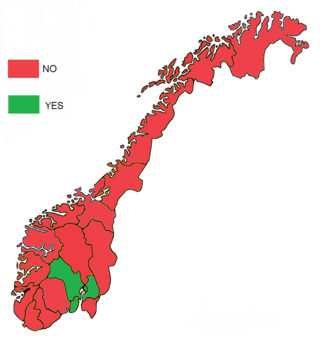A trade union or labor union, often simply referred to as a union, is an organization of workers whose purpose is to maintain or improve the conditions of their employment, such as attaining better wages and benefits, improving working conditions, improving safety standards, establishing complaint procedures, developing rules governing status of employees and protecting and increasing the bargaining power of workers.

A referendum on joining the European Community was held in Norway on 25 September 1972. After a long period of heated debate, the "no" side won with 53.5% of the vote. Prime Minister Trygve Bratteli, who had championed a "yes" vote, resigned as a result. This was Norway's second attempt at becoming a member, after having been vetoed by France in January 1963 and again temporarily in 1967, but the first attempt with a referendum on a set of fully negotiated accession terms.
The United Federation of Trade Unions is a general union in Norway. With a membership of 150,000 it is the largest private sector union in the country.

The Norwegian Union of General Workers is a trade union in Norway. It has a membership of 33,000 and is affiliated with the Norwegian Confederation of Trade Unions (LO).

Norwegian Industrial Workers Museum is an industrial museum located at Rjukan in Tinn, Norway. Located in the Vemork power station, it was established in 1988 to allow the preservation of industrial society created by Norsk Hydro when they established themselves in Rjukan in 1907. The museum is an anchor point on the European Route of Industrial Heritage.

The Norwegian Union of Iron and Metalworkers was a trade union representing workers in the metal industry, workshops, and shipbuilding in Norway.

The Norwegian Union of Building Industry Workers was a trade union in Norway, organized under the national Norwegian Confederation of Trade Unions.

The Norwegian Union of Forestry and Land Workers was a trade union in Norway, organized under the national Norwegian Confederation of Trade Unions.

Industri Energi is a Norwegian trade union for employees in the petroleum industry, the chemical industry, the pharmaceutical industry, the aluminium and metal industry and the forest industry.

The Norwegian Union of Wood Industry Workers was a trade union representing woodworkers in Norway.

The Garment Workers' Union was a trade union representing workers in the clothing industry in Norway.
The Norwegian Union of Shoe Makers was a trade union representing workers in the shoe manufacturing industry in Norway.
The Norwegian Union of Hide and Leather Workers was a trade union representing workers in the leather industry in Norway.
The Norwegian Lithographic and Chemographic Union (Norwegian: Norsk Litograf- og Kjemigrafforbund was a trade union representing printers in Norway.
The Norwegian Union of Bricklayers was a trade union representing masons in Norway.
The Norwegian Union of Stone Industry Workers was a trade union representing stonemasons and quarry workers in Norway.
The Norwegian Bakery and Confectionery Workers' Union was a trade union representing workers in the baking trade in Norway.
The Norwegian Tobacco Workers' Union was a trade union representing workers involved in making cigars, cigarettes and related products in Norway.
The Norwegian Union of Meat Industry Workers was a trade union representing workers in abattoirs and butchers in Norway.

The Norwegian Union of Telecommunication Workers was a trade union representing fitters and delivery workers at Televerket.










